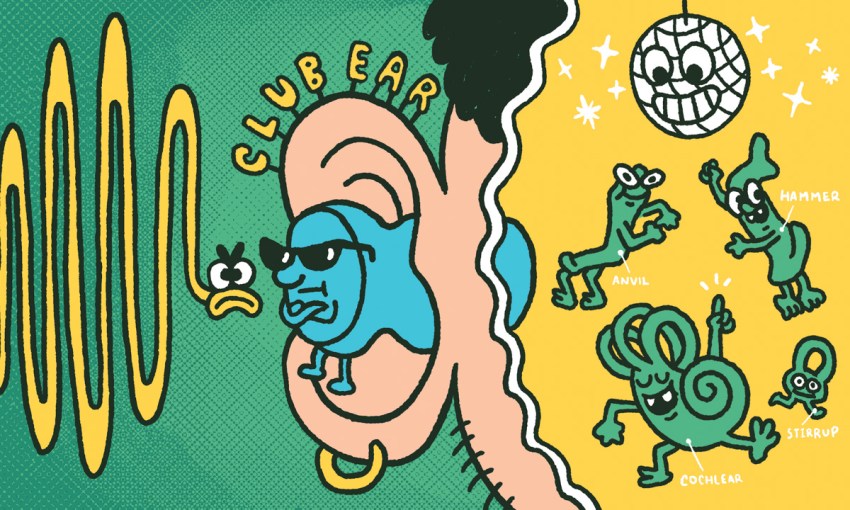An orchestra of South Australian experts, industry professionals and punters are making noise about tinnitus and the importance of plugging your pinna when seeing live music to prevent a lifetime of ringing.
The inner turmoil of tinnitus
Erik Zarins has a claim to gig-attending fame many melomaniacs would be green-eyed over.
“Back in the day at The Thebby, I saw Nirvana,” says Erik, a man referred to by his friends as a six-foot-four gentle Latvian giant. “I was about a quarter of the way back,” he says of the 1992 gig. “It was amazing.”
According to Internet Archive — an online trove of historical sonic bits and bobs — the grunge three-piece started their set with drum blasts from ‘Aneurysm’, the closing song from the 1992 B-side and rarities album Incesticide.
Just before the band starts, the hungry crowd erupts in whistles, hollers and yelps. For live music fans, this is the feverish moment where the room is filled with the sound of the audience. You, as one member of this horde, get to show your appreciation for the music makers. “I like the atmosphere,” Erik says.
Now in his fifties, Erik rarely attends concerts. Not because he doesn’t want to – he’s still a massive music nut – but being at these shows impacts his health. The pensioner has hearing loss and tinnitus, the latter of which he’s lived with for 30 years.
“You gotta laugh about it, otherwise you’ll cry,” says Erik, a former front-and-centre mosh-pit frequenter and active member of the local music scene. “It’s hell breaking loose in my head, and it’s been there since I was 24, and I’m now 54.
“I used to love loud music and playing in bands, but I can’t even hear the tune now. I was a bass player, and so now I don’t play music and I don’t go out. It has affected me detrimentally.”
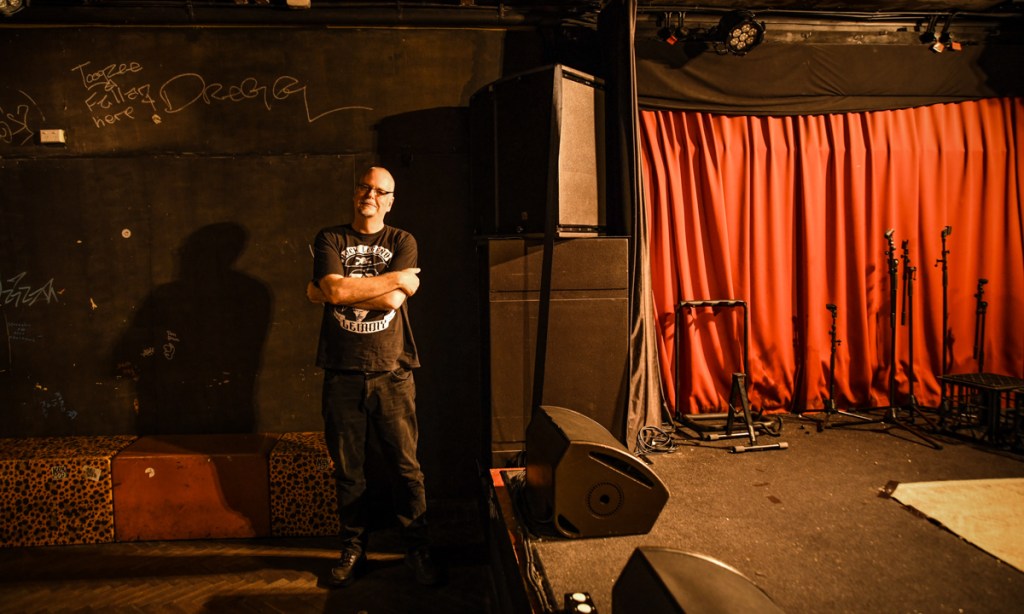
Erik Zarins in the Crown & Anchor’s band room
Tinnitus is a disability characterised by ringing or buzzing in the ear with no external source, incurred by listening to consistently loud or sharp bouts of sound.
Erik’s tinnitus is fairly severe. Audiologists clocked his internal hiss at 80 decibels. That’s equivalent to a busy downtown street, blaring alarm clock or screeching welding equipment. A conversation is usually 55 decibels, while the higher end of the scale, 145 decibels, is equivalent to a jet taking off. Hearing becomes uncomfortable at 110 decibels and causes pain at 130.
Even talking about the never-ending white noise is stressful for Erik, who developed significant mental health issues from the irreversible injury. “Tinnitus can lead to mental trauma,” he says. “You don’t sleep and you have trouble coping and functioning.”
Erik, who was born with meningitis, believes he’s seen 12 ear, nose and throat specialists for assistance. They pointed him to tinnitus support groups, which didn’t work. They only amplified Erik’s awareness of the buzz. He gave up listening to music and playing in a band for a year after an experience with tinnitus which felt like a slap in the head.
Decades later, it’s also turned Erik nocturnal.
“Things are a lot quieter at night, and you can hear the ringing a whole lot more, so I sleep in the morning,” he explains. “I [also] have the TV on. People say, ‘But that wouldn’t help you sleep, a TV, would it?’ But you’d be surprised. When I’m tired, I will turn to my side and then I’ll just crash.”
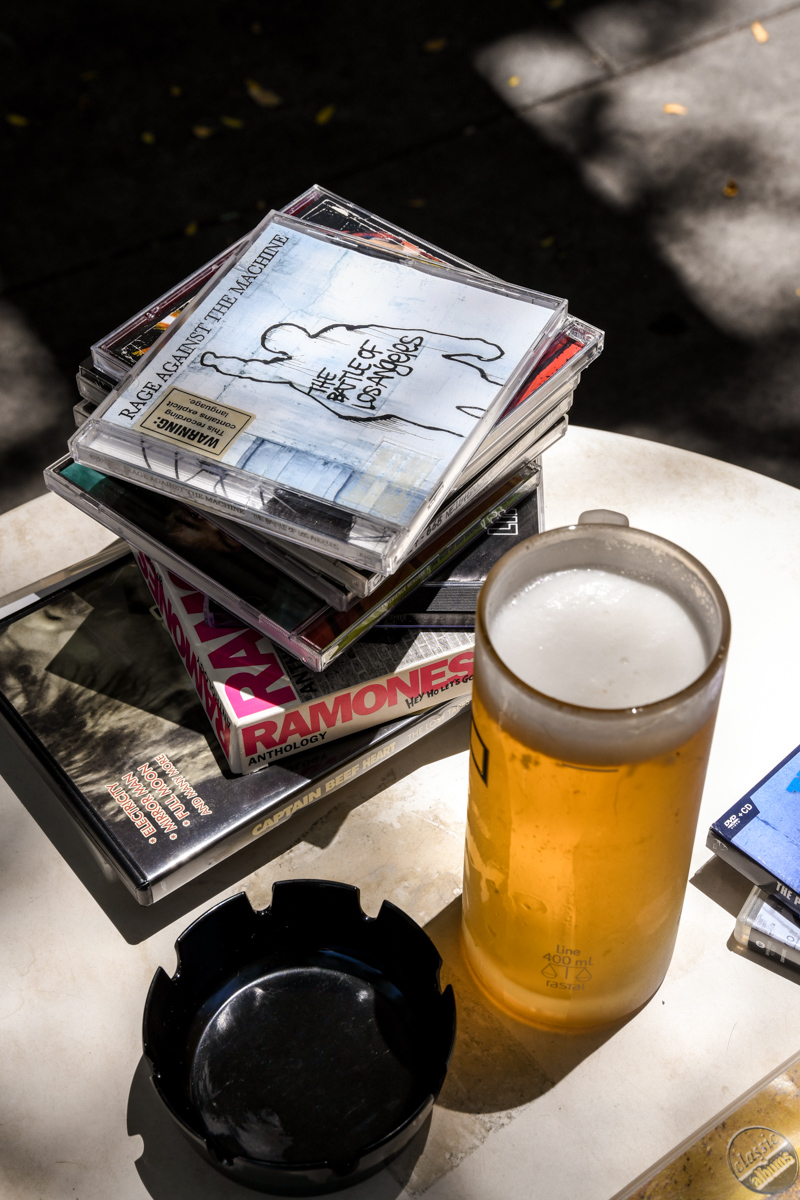
A stack of Erik’s beloved musical items
A recently published paper found the estimated number of young people at risk of developing hearing loss due to exposure from unsafe listening practices globally is between 0.67—1.35 billion. The World Health Organization blames personal audio devices (like ear buds and headphones), as well as certain venues, such as nightclubs, bars, concerts and sporting events, for causing tinnitus and hearing loss.
Professor Raj Shekhawat heads up the Flinders University audiology department — South Australia’s only higher-education facility dedicated to peoples’ hearing, and one of only seven in Australia. Speaking over the phone, Raj says “one in six Australians suffer from tinnitus”. For most people, it’s a temporary condition, but for some it will stay forever. “For one in 10 of them, it lingers on,” Raj says. “And then it starts interfering in their day-to-day life.”
Raj explains the part of the brain responsible for processing sound is close to the part that deals with emotions. This means “sound can evoke emotions,” he says, and with tinnitus being a persistent aural presence “our limbic system, or emotional system, gets involved into it. That’s when it becomes really hard and challenging for these clients to be able to not pay attention to it.”
The ear is a complex organ, made up of the pinna (the visible part of the ear); the ear canal, which leads to the ear drum; the middle ear, where three tiny bones, known colloquially as the hammer anvil and stirrup, sit; and the inner ear, which contains the cochlear.
Sound vibrations that reach the ear drum rattle the hammer, anvil and stirrup, which then tap on the cochlear, sending vibrations to tiny hairs that exist inside it. These hairs convert the vibrations into neural impulses, which are then transported down the auditory nerve super-highway to your brain.
Raj says if a sound is too loud, you may damage this armada of tiny hairs, making them bend or break — leading to hearing loss or a ringing. Once they’re damaged, there’s no way to repair these hairs.
Professional musicians will sometimes employ their own defences against noise while playing live, including using bespoke ear plugs moulded to the interior of their ear. Or, they can opt for in-ear monitors, which are an earbud-like version of a foldback speaker, which bands use to be able to hear each other on stage.
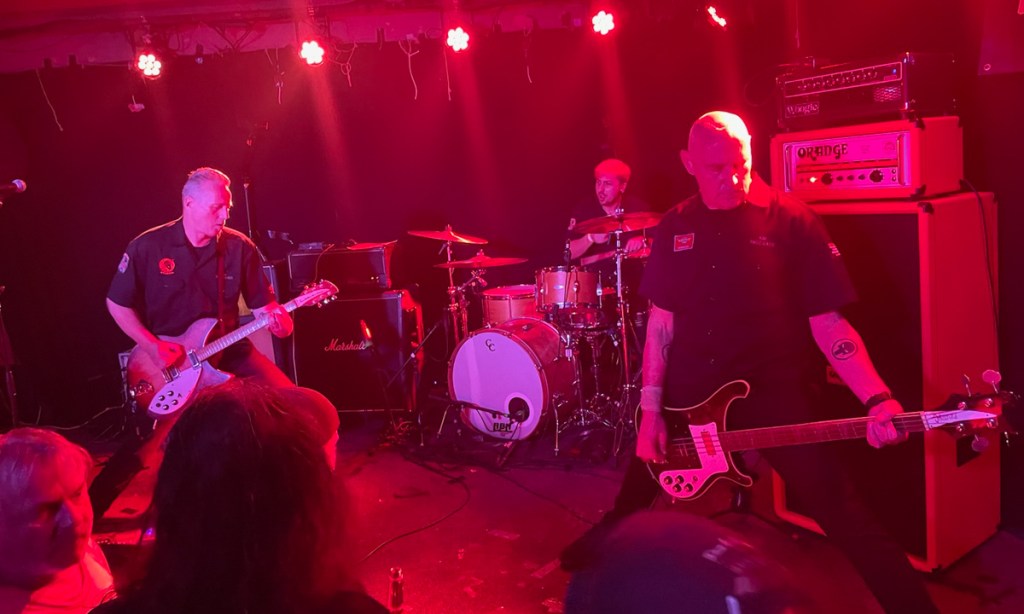
The Mark of Cain. This picture: David Eccles
John Scott sings and plays guitar in The Mark of Cain — an Adelaide punk and alternative-metal progenitor from the mid-‘80s. The trio’s repertoire is heavy, lurching and despondent, with one of their most famous songs, ‘LMA’, released in 1995, ringing with heavy reverb, swirling guitars and lyrics of love and loss. This shoegaze quality creates a wall of sound, and has absolutely impacted John’s hearing.
“It’s terrible; it’s really bad,” he says. “It’s been 30-odd years of loud music.”
John describes the perennial ring in his head as a high-pitch white noise, and “particularly noticeable at nighttime, [and] even office areas,” he says.
The veteran musician believes his on-stage proximity to the drum kit’s ride cymbal, with its brash, metallic explosions, has pulverised his hearing. As a result, John sometimes uses “one” earplug when performing. He has also tried hearing aids, but they didn’t ameliorate the ringing. Unlike other professional musicians, he also detests in-ear monitors — the gold-standard — describing performers who use them as “fake”.
“If you’ve got everything turned down, and you can actually hear what you’re playing, they’re not actually reacting to the musical sound pressure that’s coming off the amps on stage,” John says. “That’s an act.”
This is an important element of playing music to John. Being able to feel the music physically connects the musicians and audience in a collective experience. “It’s the vibrations, that whole idea of the universe and we’re all vibrations, and it’s like a visceral connection with an audible, unseen sound wave hitting your body,” he says.
Even with this philosophy, John acknowledges his artistry has come at a cost. If he could turn back time and wear ear plugs to shows religiously, he would.
“I accept that this was my little bit of suffering for my art,” he says flatly.
Tinnitus also effects musicians early in their career. Up-and-coming alternative music prodigy Ricky Albeck is recording a new album at recording studio Interim when we catch him on the phone. He’s been playing in bands for six years, and has developed a persistent ringing over that time. He has lost some higher-end frequencies, but it’s the relentless buzz that bothers him.
“I can’t really sleep in a silent room,” Ricky says. “I need to have something going, like a fan, otherwise there is a loud ringing in my ear.”
Much like John, Ricky doesn’t regularly use ear plugs when performing live.
“I’m a firm believer in not sacrificing the sound in place of having the earplugs in,” he says. “A friend of mine always wears hectic earplugs and then he always has his guitar way too loud at practice and at gigs. I think it’s because he’s got the earplugs in [and] he needs to turn his guitar up louder so that he can hear it, but then he’s sacrificing the mix of the band.”
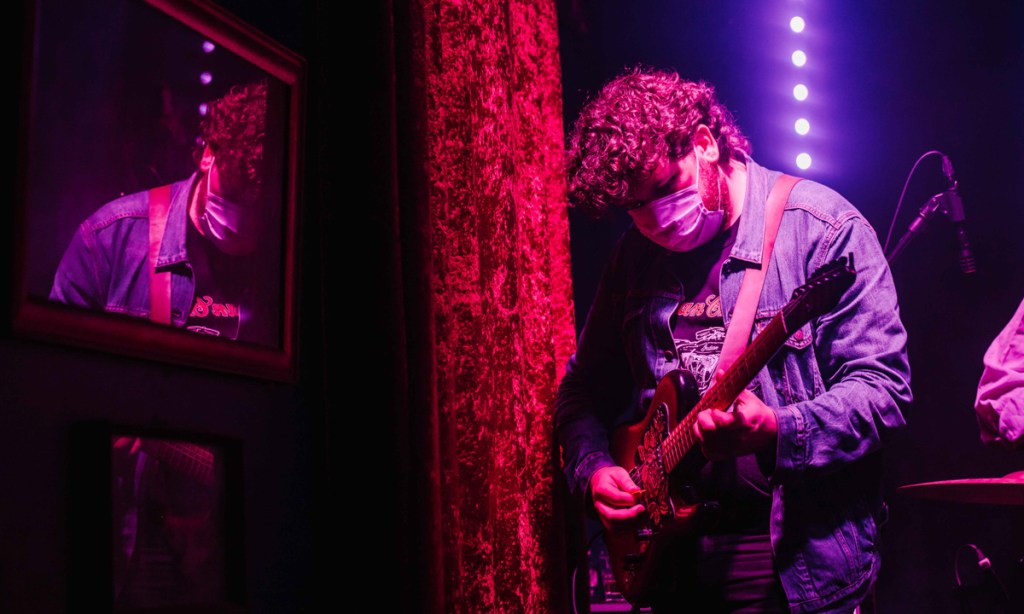
Ricky Albeck playing in Workhorse at the Grace Emily. This picture: Roman Wojtkowski
Ricky plays alongside a rotating cast of characters at inner-city venues, including the Crown & Anchor, which slings $2 foam earplugs from behind the bar. Bar manager Chad Pearce says the venue sells roughly 20 pairs a week, with sales fluctuating depending on genre and crowd.
“Hardcore and metal shows normally get more peeps asking for earplugs,” he says. “And then we also go through more when the audience is an older demographic.”
Money generated from earplug sales is donated to Girls Rock!, a not-for-profit which nurtures non-male and gender diverse talent in the music industry, and the Cora Barclay Centre, a medical clinic on Melbourne Street providing audiological services, such as cochlear implants and speech processors, for children who are deaf or hearing impaired.
The University of Adelaide’s Elder Conservatorium of Music, the oldest tertiary music school in Australia, employs a range of techniques to stave off tinnitus. The facility has dosimeters within all its studios, rehearsal spaces and control rooms to measure sound.
“For all of those spaces, we have them calibrated, which for most of those spaces would be 88dB,” says sonic arts teacher Sebastian Tomczak. “Any of the spaces that are elevated to 88dB, we would have a four-hour limit in terms of bookings. The rehearsal spaces are calibrated at 91dB, so they have a two-hour time limit. If they go beyond the levels, then the dosimeters will flash red.”
In high school, Sebastian played bass in a swag of metal and rock bands. As a result, his right ear copped a belting from the drum kit. “They’re damaged,” he says of his ears. Although it’s Sebastian’s job now, decades later, to educate his students about the realities of their future noisy careers, he says he didn’t receive in-depth technical knowledge growing up. But now it’s part of the curriculum.
Sebastian says at the Con, educators, and a range of ensembles, such as big and Latin bands, spent 10 weeks trialling 10 different sets of ear plugs. One brand was a strong winner, and as a result, “we ended up just buying like 100 pairs of these earplugs, and they were maybe 30 or 40 bucks each,” he says.
For orchestras with horn sections — another noisy stage presence — teachers also tried Plexiglass shields and putting players on risers to avoid “potentially [playing] sound directly into the back of the head of the trombone player in front of them,” Sebastian says.
After 18 months of experimentation, the earplugs still came out as the clear, cost-effective winner.
Audiological expert Raj believes the responsibility of safeguarding our hearing is shared between venues and festival organisers, which can create greater awareness of the dangers of loud noise and the availability of earplugs. They could even include the price of a pair in the cost of a ticket, he muses.
But to Erik, there will always be a group of kids who don’t want to wear the goofy $2 orange plugs. For those that do take the risk, he hopes they pay attention to the post-gig ringing in their ears.
“Tinnitus is one way of saying, ‘Hang on a second, you’re going deaf,’” he says. “And as the world becomes louder, the ringing is going to become more prevalent.”



